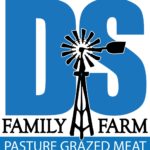Worried about what you are "really" eating? Have peace of mind with pasture grazed meats.
2023 Pasture Pork
This is our second year raising and grazing pasture pigs. We have made changes from our experience last year. In 2022 we used a Mobile Pig Pen and you can read our summary from year one. In 2023 we doubled the herd size to 8 pasture pigs and eliminated the portable pen. We are moving the pigs similar to how we handle the beef herd, behind portable electric poly wire.
One Poly Wire?
We purchased our pigs after weaning in early July. Through September we have been able to keep the pigs on the move with a single electric poly wire. Resources on the internet suggest two poly wires to contain pigs. We are ready to add a second wire if needed, but the single poly wire is currently working fine. Trees have provided all the shade needed for the pigs this year. Pig herd moves have been about once a week with plenty of space for them to explore on each move.
“Fresh Grass and Move” is how we treat all the animals we raise. Frequent moves result in excellent animal health. In this process, we mimic how nature works. Animals use and dung an area and move on to a fresh patch of land. The result, soils and vegetation are regenerated.
Water
Notice the black pipe shown in the bottom left of the above photo? This is a 3/4 inch poly pipe delivering water to the herd on the move. Hauling water is a job we try to avoid. During the non-frost part of the year, we use the black poly pipe across the pasture surface to follow all of our animals on the move with water. Though I am sure the pigs could easily chomp through this pipe, create a water leak, and make a mud wallow, they simply have not bothered the pipe. A water barrel with a float valve (photo below) provides water for the herd. Thirty gallons of storage will provide water for a couple of days if the water source is interrupted. A screen below the nipple provides “some” protection to the soil from pigs creating a wallow hole.
Portable Feeders On Skids
We came across these “Osborne Wheel Feeders” that work great. They are portable and adding a “lid” to the feeders protects the feed from the elements. We ordered a new lid (green) from the company which was very expensive. The black stall cover, cut to fit the feeder top, was a cheaper and just as effective option to protect the feeder. A “wheel” in the bottom of the feeder “spins” out feed as the pigs push feeder arms with their nose. A couple of days of feed can be added to the feeder and the pigs will meter the feed out as they like.
Pig Impact
Managing animals for appropriate impact on the farm regenerates soil and forages. Animal impact is an important part of every ecosystem. We are excited about the impact pigs will have under tree areas. Pigs need protection from the sun and they love to root around under the trees. Cattle will retreat to trees for shade but provide little impact on tree areas besides just concentrating in an area for a short time. Pigs, armed with their snout, provide wonderful impact under trees and not so much impact out in the grass pastures. Pigs complement our cattle herd by providing animal impact across more of our farm landscape.

Based on our second year experience with pigs, we will look to expand the herd size again in 2024. The experts tell us that a pig herd of about 14 is the maximum size before the herd becomes unruly. Twelve might be the magic number.









